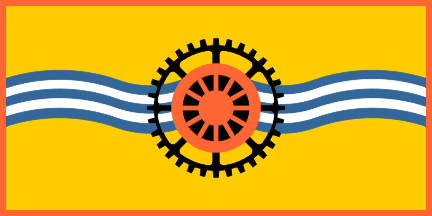 image by Martin Grieve, 16 Mar 2009
image by Martin Grieve, 16 Mar 2009
Last modified: 2015-08-29 by bruce berry
Keywords: south africa | klerksdorp |
Links: FOTW homepage |
search |
disclaimer and copyright |
write us |
mirrors
 image by Martin Grieve, 16 Mar 2009
image by Martin Grieve, 16 Mar 2009
Klerksdorp is the centre of a large gold mining and agricultural economy and boast the second largest grain co-operative in the world. It is located on the N12 national road, approximately 200km south west of Johannesburg in the North West Province. The town was the first white settlement in the former Transvaal being established by a small community of Voortrekkers that settled on the banks of the Schoonspruit in 1837. The first magistrate, Jacob de Clerq, gave his name to the town. In 1886 gold was discovered and thousands of prospectors descended on the quiet rural aggregation of Klerksdorp transforming it into a mining town. Today the city enjoys a healthy economy based on gold and uranium mining and agriculture, and it is the administrative centre for the Dr Kenneth Kaunda (formerly Southern) District in the North West Province. The world's second largest grain co-operative, the Central Western Co-operative Company (or Senwes as it is colloquially known based on its Afrikaans name), has its headquarters in the town.
The municipal flag of Klerksdorp was registered with the South African Bureau of Heraldry on 20 February
1968 with the following description:
"Within a red border, three horizontal stripes of equal
width, yellow, blue and yellow, the blue one wavy and thereon two
smaller white stripes wavy; over all a black cogwheel surmounted
a red wagon-wheel". This flag was a heraldic banner being based on
the shield from the municipal coat-of-arms. The flag was unusual in that it did not follow the
standard South African proportions of 2:3 but was instead 1:2.
nw-kl.jpg) scan by Bruce Berry, 14 Mar 2009
scan by Bruce Berry, 14 Mar 2009
The blazon of the Arms registered with the Bureau of Heraldry on 01 June 1966 is as follows:
Arms: Or, on a fess wavy Azure two bars wavy
Argent, in chief a demi-cogwheel Sable surmounted by a demi-wagon-wheel Gules, and in base an Afrikander
bull's head and hump Gules, attired Or.
Crest: A mealie cob erect with four leaves
Or.
Wreath: Or and Azure.
Motto: MAJORA PERSEQUENDO PROFICIMUS
The wavy blue lines allude to the Schoonspruit, on the banks of which the original Voortrekkers established the town in 1837. The wagon wheel represents the Voortrekkers as the original inhabitants of the town while the cogwheel represents the importance of secondary industry and the benefits which accrue to the town due to the nearby mining of gold and uranium. The bull's head refers to the adjacent cattle industry while the mealie cob alludes to the fact the Klerksdorp lies in one of the largest maize producing areas in South Africa and is home to a large maize co-operative. The motto translates to "We make progress by pursuing greater ideals".
nw-kl1.jpg) scan
by Bruce Berry, 14 Mar 2009
scan
by Bruce Berry, 14 Mar 2009
Following the re-demarcation of South African local authorities in December
2000, Klerksdorp, Hartbeesfontein, Orkney and Stilfontein amalgamated to form a new local authority
called City of Matlosana and new municipal symbols
were adopted. The new municipal logo comprises two human
figures with arms and legs outstretched against a yellow and green stripe
reflecting the gold mining and agricultural basis of the area with the figures
evoking the dynamism of its people.
Bruce Berry, 14 Mar 2009